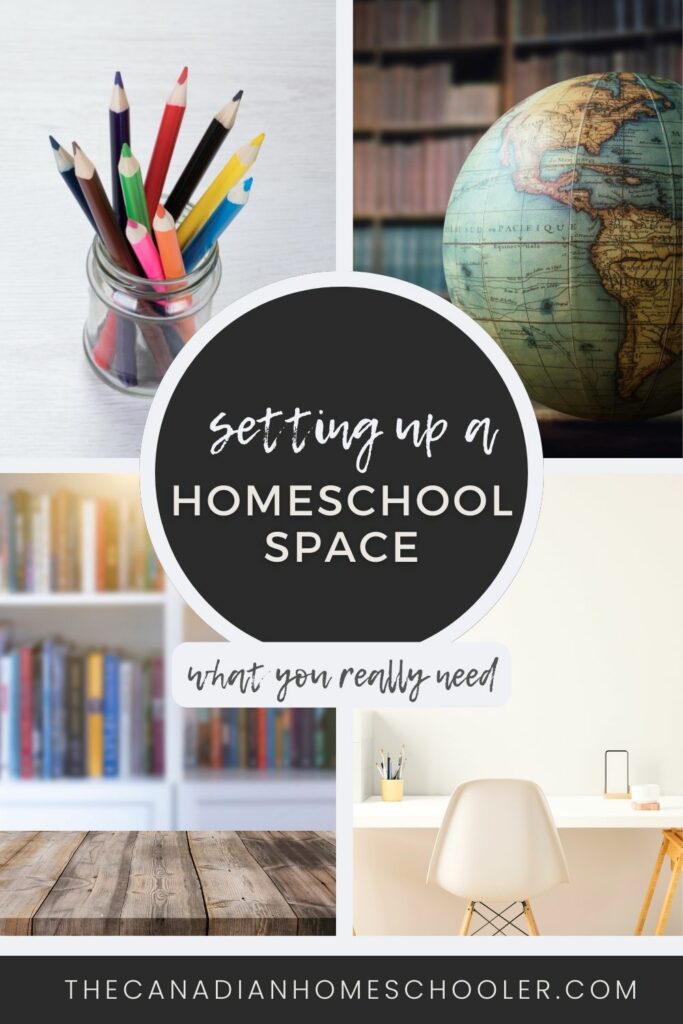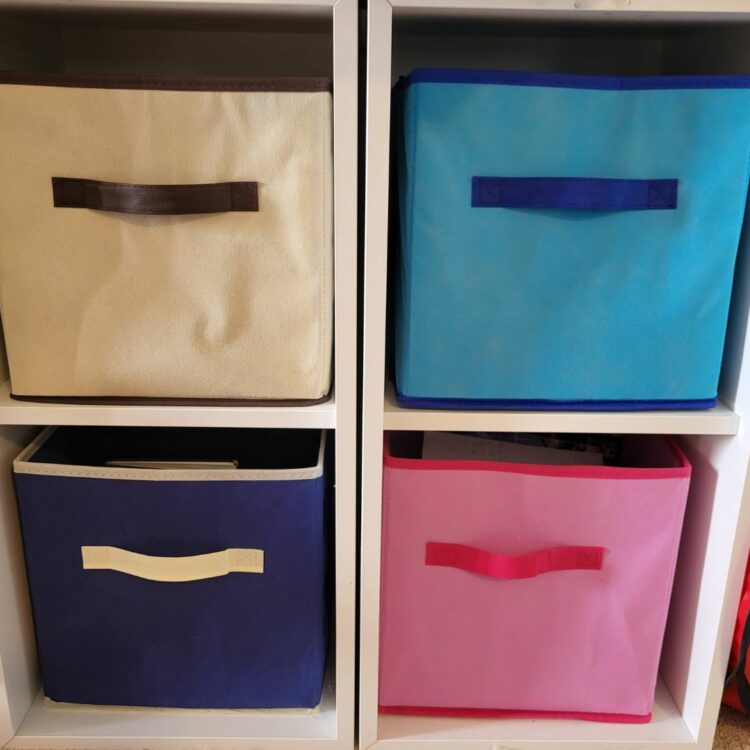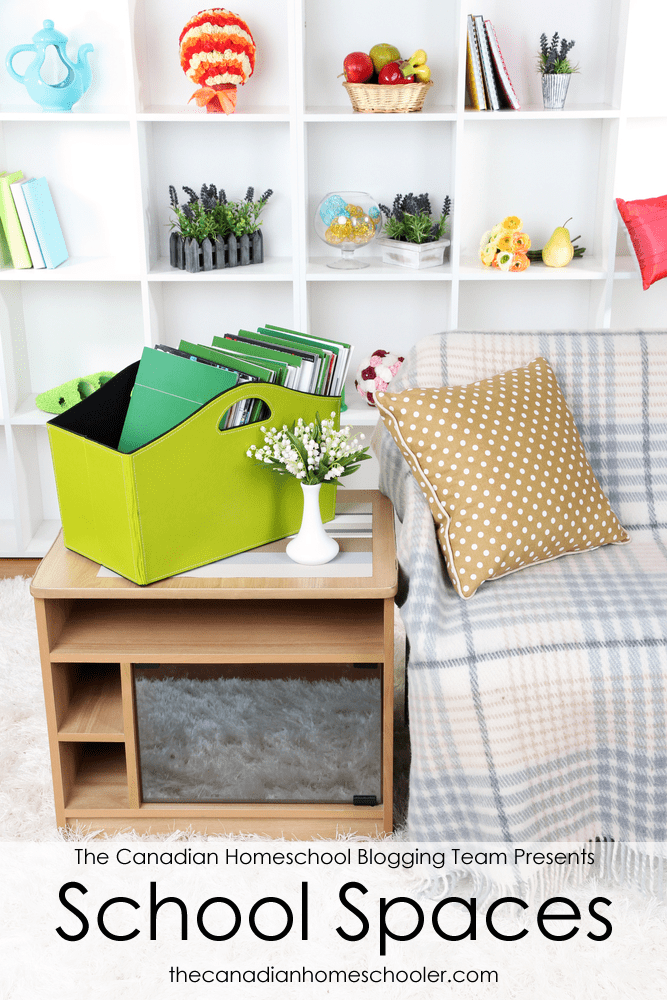One of the first things that a new to homeschooling parent thinks of is the “classroom.” Since schools have dedicated space for learning, it can be tempting to look through all the beautiful pictures of amazing homeschool rooms on social media and dream of wanting something similar. Aesthetically, it can be breathtaking – especially with the right camera angles, colour schemes, lighting, and decorations.
But the truth is that you don’t need to invest money into creating a dedicated homeschool space. You can use the pieces of your home that you use on a daily basis already.
If you ask a group of experienced homeschoolers where they find they do most of their work, you will probably find a large group of them mention three places: the kitchen table, the couch, and “anywhere.”
But there are some things to consider when setting up your homeschool space. And that’s what we’re going to talk about in this post.

This post contains affiliate links.
School Supplies You Use Every Day
Typically, there are a set of school supplies that you will need access to every day, like pencils and pens, scissors, glue, and erasers. Think of a place where they can be easy to grab and use in the middle of doing work or when a creative moment strikes. Having to stop the flow of work to go dig out a glue stick from somewhere or to find a new pencil because all the usual ones have disappeared can really interrupt the day.
In a house where everyone shares all the resources, you can find something to put in the middle of the space with all your supplies in it. Some popular options include using desk organizers – especially ones that spin for easy access. Another is to put things into mason jars in the middle of the table. Some use various bins or have a special drawer set aside for just these supplies.
If you prefer to have separate supplies for each child, using labeled bins or pencil cases can help keep things organized and easy to recognize. A popular suggestion is to colour or pattern code your supplies so each child has their own. For example, kid #1 could have a blue pencil case and a blue notebook with a pair of blue scissors while kid #2 would be green and kid #3 would be pink. You can also use decorative tape, like washi tape, which come in a wide variety of colours and patterns to designate specific supplies to specific children.
Kids’ Books & Learning Materials
If your children are using curriculum or printed resources in any way, you will need a space for them to keep their work which will be easy for them to access when it’s time to get their schoolwork done for the day.
How you decide to do this will depend on your house and the space you have available. Here are some ideas:
- a dedicated shelf where all the schoolbooks go.
- flat plastic bins with lids that snap closed – one for each child
- A rolling utility cart with multiple drawers – this is a popular way to have each drawer be used for each subject (ie. one drawer is math, one is language, one is science, etc).
Personally, I use a set of shelves with fabric bins that I bought from the dollar store. They aren’t the strongest and we have to replace them almost annually, but they look nice and are an easy way to keep things organized and out of the way.
Your Teacher Resources
Depending on the curriculum you choose, you may find that you have a collection of teacher guides and resources that you need to reference throughout the day. Or you might have some read alouds or games that you want to be able to pull out. If you have tech tools that you want to be in charge of or other things that are your responsibility throughout the homeschool day, you will need a place ot keep it all nearby.
Again, this is based on your house and needs. Over the years, I’ve seen homeschool moms who love using a 3-shelf kitchen unit that can be wheeled around as needed. There are some incredibly creative ways to use this cart – such as filling the top with magazine holders to put books in, mason jars for all the school supplies, and more. A quick look on Pinterest can inspire some creative solutions.
At our house, I use a shelf or one of the fabric boxes like the kids. It’s just easy to go and grab what I need when I need it or to carry my box to whatever room we’re working in.

A Homeschool Workspace
Your children need somewhere to do their schoolwork, make art, play games, and build things. This is where lots of people first envision a set of desks for each child and recreating a classroom. If you have a small house, this can be impossible to imagine.
The good news is you don’t have to. There are lots of places where kids can do their schoolwork around your house already.
- The kitchen table or island
- The floor
- The couch
- Their bed
- The grass in the backyard
- The car
- A patio table
Anywhere can be a potential learning space!
However, if you have schoolwork that will involve writing – it’s best to use a harder surface to avoid frustration.
At our house, we have a couple lap desks – which are pillows with a hard top that you can use as a writing surface. They are easy to take and go to whatever room we are working in that day. We also have a set of foldout TV tables, which we can pull up to the couch or computer desks whenever they are needed.
Every child in my house does have their own desk in their rooms. But I’m not sure that any of them have ever used them to do schoolwork at! They mostly use them for their own hobbies and activities.
If you do decide you have the space or need for a desk for your child, here are some tips:
- What can you repurpose from your house already? For example, I have a wooden desk that I used as a child which I was able to give one of my boys when they wanted a desk. I also have a well-loved craft table from before any of them were born that was able to reused as a workspace for one of my kids.
- Look into local freecycle style groups. There are many of these on social media. See if anyone has something that will work for your situation.
- Check thrift stores. I’ve gotten amazing like-new furniture at thrift stores over the years, including desks!
- IKEA makes great quality desks for a reasonable price point, if you decide that you need something new.
Just remember, especially if you are new to homeschooling, to not spend a lot of money on furniture to set up a workspace at first. Use what you have and then see what you need so you can adapt from there. School at home doesn’t need to look and feel like school at school. Wait and see.
School Supplies You Only Use Sometimes
There are lots of miscellaneous things that you accumulate when you homeschool. Like art supplies, science equipment, puzzles, games, math manipulatives…… they all pile up! These aren’t usually things that get used on a daily basis, so you will need to find somewhere to keep them.
Not everything needs to be out and ready to go at all times. It’s fine to put things away until you need them.
Decide which of these supplies need to be kept where.
- Do you use it every other day? Then keep it close.
- Do you use it every once in a while? Then it can go to the basement.
- Will it make a mess, stain the floors, or break if a child gets into it when you don’t realize it? Keep it up high.
- Do the kids need easy access to it when creativity or interest strikes? Put it somewhere they can access.
Over the years, I’ve found the best success at keeping the “little” things in labeled containers. That means all our acrylic paint is in a bin. All our stamps are in another. Everything science has its own container. Then, I just go to the closet / cupboard, find the right bin, and pull out what we need.
And don’t be afraid to go through and get rid of things when they get to be too much. Check your markers for ones that dead. Check for paint that has dried up and throw out playdough that’s been around too long. When you kids age up, pass along things that are too young for them to use anymore. Throw away puzzles missing pieces and paper scraps.
Don’t let the accumulation of educational extras drown you in chaos.
What if you have it all, but can’t figure out how to get it organized?
I feel you. OH, how I feel you. That’s why I made the “Organize Your Homeschool in 20(ish) Days” challenge. Because our school stuff takes over and I needed to be able to successfully get through it all.

It’s all broken down into the main areas of our homeschool “stuff” with simple tasks to complete each day throughout the challenge. At first, it seems a tad ridiculous – (“Just pencils and pens today?!”) but there’s a reason for that! It’s all about small wins to keep you encouraged to keep going. Because when you tackle a whole challenge at once, it’s far too easy to get overwhelmed and quit. I didn’t want that. I wanted everyone to succeed.
Setting up a homeschool space doesn’t need to be expensive or complicated. You don’t need to find a way to make a classroom in your house – you just need to find somewhere to keep the school supplies, learning resources, and tools you will need closeby and accessible. When people ask me where we do school in our house, I have one main answer: “Wherever the kids are willing to learn, is where I’m willing to teach.” Even if that means laying on the trampoline on a sunny day, or sitting on someone’s bed with their math.
This post was originally published in 2016 as a collection of posts from other Canadian homeschoolers. It has been rewritten in 2024. Find other ideas and suggestions on setting up a homeschool space below.
Homeschool Spaces of Other Families
Want to take a glimpse into the school rooms of other homeschoolers? Here’s your chance to take a tour.

Bonnie – Our Homeschool Room
Our homeschool room is our dining room. When it’s time for school, we just pull out books and sit down to work, then clear them off later to have lunch or supper.
Alison – Homeschooling Without a Schoolroom
We don’t have a “schoolroom”. You can walk through every room in my home, and you will not see any alphabet posters, 100’s charts, or “learning centres”. It’s quite possible that a complete stranger could take a walk through my home and not even know that we homeschool! It’s pretty important to me that our home look like, well, a home. I’ve not once in my life felt comfortable or at home in a classroom, so why would I want one in my home? So, if we don’t have a school room, where do we homeschool? And how do we keep our house from looking like a school or being overrun with art supplies, books and other clutter?
Ana – 7 Tricks to Organize Your Homeschool in Your Dining Room
Hey, friends! Today I want to show you how to organize your homeschool space in your dining room without having your dining room looking like a full classroom! Tomorrow I will show you how I organized our homeschool resources in our living room. So don’t miss part 2 of this blog post coming up! Welcome to our home and to our homeschool space, after all, our HOMEschool happens where life happens the most in our home daily, in our living space! I will start showing you how we organize our homeschool resources around our dining room table because this is where we spend most of our learning time at.
Jennifer – How to Organize Your Small Homeschool Space
Is your home too small for a separate homeschool room? Here’s my list and photos of homeschool organization tips for the small homeschool space.
Annette – Where We School – Homeschooling Spaces
The new school is almost upon us! I know, I know.. only a week to prepare, man, I feel like I am running out of time to get things ready and moving forward. As I think about getting ready for school, some of what I think on requires doing some cleaning and rearranging, and then I need to think about how we do school in our house. Perhaps you do the same thing as you prepare?
Andrea – Our Homeschool Space…or…Look How Messy We Really Are!
Find a space that works for you. And if it isn’t completely picture perfect on the first day of school? Don’t worry about it. It will eventually come together.
- How to Keep a Toddler Busy While Homeschooling - March 21, 2024
- 25+ Things Your Kids Learn From Video Games - March 20, 2024
- 10 Words For New Homeschoolers - March 20, 2024


This is great! I love the variety of spaces and organization strategies shared here.
Thanks for including our homeschool “space” too!
Wishing you a lovely day.
xoxo
This was nice to read! I have often wondered whether other homeschooling families just use the dining room table like we do. We bought our daughter a desk when she was about 9, but she didn’t like being reminded of schoolwork when she was in her room, so the desk migrated to the living/dining room, where I now use it, and she happily does her work at the table – with free time in her room to change her mind entirely! (Friendly note: I am the author of Canadian Winter Homeschool Materials, based in Montreal, and available at currclick.com. Or visit https://canadianwinterhomeschoolmaterials.wordpress.com/) Best wishes for a happy homeschool year!
Thanks for stopping by my blog and for sharing your resources! 😀
thanks for organizing this Lisa. 🙂
I homeschool without a classroom too. We do have a large basement but it doesn’t have windows so we homeschool upstairs where we have super large and bright windows. I love the ideas you guys have. We do our work at the dining room table too and have plastic drawers and 1 wooden cupboard that holds most of our homeschooling books and manipulatives. We too collect books like crazy. I definitely need more bookshelves. I try to use all our corners, and areas for stuff. I don’t mind tacking maps to our walls. If nothing else it is a conversation piece. The kids always refer to the maps (our province) as well. Love the ideas. Thank you fellow Canadians!